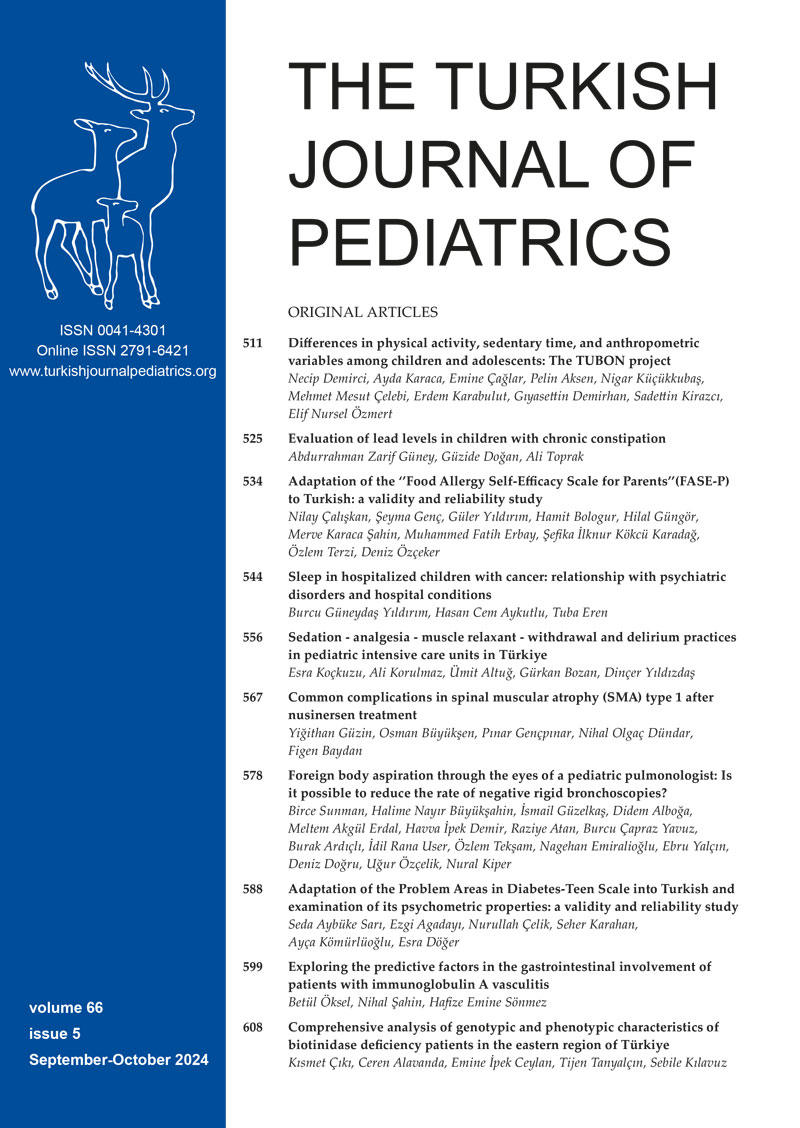Abstract
Background. Identifying a foreign body aspiration (FBA) still remains a diagnostic difficulty. Moreover, the indications for bronchoscopy in subjects of suspected foreign bodies are not clear. The aim of this study was to evaluate the effectiveness of pediatric pulmonologists in diagnosing FBA.
Methods. This was a retrospective, single-center study on children who underwent rigid bronchoscopy for suspected FBA. Data on the patients were obtained from the medical records. Patients who had foreign bodies (FB) identified during rigid bronchoscopy were classified as FB positive, and those in whom rigid bronchoscopy did not detect FB were defined as FB negative. Demographic data as well as consultation status with a pediatric pulmonologist were compared between these two groups. Furthermore, the patients were categorized into three groups based on their clinical scores that assessed the likelihood of the presence of FB: low risk, moderate risk, and high risk.
Results. Out of 474 rigid bronchoscopies, 232 (48.9%) detected FB. Consultation by a pediatric pulmonologist was not requested in 388 (81.8%). Out of these 388 patients, 206 (53%) were negative for FB. In terms of FB detection success, there was no difference between individuals who sought pulmonology consultation and those who did not (58.1% vs. 53.1% respectively, p=0.059). However, when the children were categorized based on their risk levels, the incidence of detecting FB among children in low-risk group was 42% when they received consultation from the pulmonology department, whereas this incidence dropped to 5.6% when pulmonology consultation was not sought (p<0.001).
Conclusions. Consulting a pediatric pulmonologist, particularly for low-risk individuals, might reduce the likelihood of performing unnecessary bronchoscopies. Given that rigid bronchoscopy is an intrusive technique, it is crucial to reduce the number of negative bronchoscopies in order to mitigate complications associated with it.
Keywords: foreign body, pediatric pulmonologist, rigid bronchoscopy
References
- Mathew RP, Liang TI, Kabeer A, Patel V, Low G. Clinical presentation, diagnosis and management of aerodigestive tract foreign bodies in the paediatric population: part 2. SA J Radiol 2021; 25: 2027. https://doi.org/10.4102/sajr.v25i1.2027
- Cataneo AJ, Cataneo DC, Ruiz RL. Management of tracheobronchial foreign body in children. Pediatr Surg Int 2008; 24: 151-156. https://doi.org/10.1007/s00383-007-2046-z
- Heyer CM, Bollmeier ME, Rossler L, et al. Evaluation of clinical, radiologic, and laboratory prebronchoscopy findings in children with suspected foreign body aspiration. J Pediatr Surg 2006; 41: 1882-1888. https://doi.org/10.1016/j.jpedsurg.2006.06.016
- Viot A, Babin E, Bequignon A, Moreau S, Vadillo M, Valdazo A. Bronchial foreign bodies in children. Ann Otolaryngol Chir Cervicofac 2002; 119: 174-180.
- Righini CA, Morel N, Karkas A, et al. What is the diagnostic value of flexible bronchoscopy in the initial investigation of children with suspected foreign body aspiration? Int J Pediatr Otorhinolaryngol 2007; 71: 1383-1390. https://doi.org/10.1016/j.ijporl.2007.05.012
- Cohen S, Avital A, Godfrey S, Gross M, Kerem E, Springer C. Suspected foreign body inhalation in children: what are the indications for bronchoscopy? J Pediatr 2009; 155: 276-280. https://doi.org/10.1016/j.jpeds.2009.02.040
- Fasseeh NA, Elagamy OA, Gaafar AH, et al. A new scoring system and clinical algorithm for the management of suspected foreign body aspiration in children: a retrospective cohort study. Ital J Pediatr 2021; 47: 194. https://doi.org/10.1186/s13052-021-01147-9
- Özyüksel G, Arslan UE, Boybeyi-Türer Ö, Tanyel FC, Soyer T. New scoring system to predict foreign body aspiration in children. J Pediatr Surg 2020; 55: 1663-1666. https://doi.org/10.1016/j.jpedsurg.2019.12.015
- Janahi IA, Khan S, Chandra P, et al. A new clinical algorithm scoring for management of suspected foreign body aspiration in children. BMC Pulm Med 2017; 17: 61. https://doi.org/10.1186/s12890-017-0406-6
- Stafler P, Nachalon Y, Stern Y, et al. Validation of a computerized scoring system for foreign body aspiration: an observational study. Pediatr Pulmonol 2020; 55: 690-696. https://doi.org/10.1002/ppul.24632
- Pozailov S, Goldbart A, Aviram M, et al. Foreign body aspiration score (FOBAS)-a prospectively validated algorithm for the management and prediction of foreign body aspiration in children. Eur J Pediatr 2024; 183: 815-825. https://doi.org/10.1007/s00431-023-05347-9
- Raviv I, Pozailov S, Avraham S, et al. Evaluation of foreign body aspiration score (FOBAS) in children- a retrospective cohort study. Eur J Pediatr 2023; 182: 4205-4212. https://doi.org/10.1007/s00431-023-05095-w
- Kadmon G, Stern Y, Bron-Harlev E, Nahum E, Battat E, Schonfeld T. Computerized scoring system for the diagnosis of foreign body aspiration in children. Ann Otol Rhinol Laryngol 2008; 117: 839-843. https://doi.org/10.1177/000348940811701108
- Cavel O, Bergeron M, Garel L, Arcand P, Froehlich P. Questioning the legitimacy of rigid bronchoscopy as a tool for establishing the diagnosis of a bronchial foreign body. Int J Pediatr Otorhinolaryngol 2012; 76: 194-201. https://doi.org/10.1016/j.ijporl.2011.11.002
- Aydin O, Birbilen AZ, User IR, Turer OB, Teksam O. Lung ultrasound findings in children with foreign body aspiration. J Clin Ultrasound 2023; 51: 447-451. https://doi.org/10.1002/jcu.23306
- Avraham S, Aviram M, Farkash Novik E, et al. Comparison of chest X-ray interpretation by pediatric pulmonologists, pediatric radiologists, and pediatric residents in children with suspected foreign body aspiration-a retrospective cohort study. Eur J Pediatr 2023; 182: 3101-3109. https://doi.org/10.1007/s00431-023-04943-z
- Foltran F, Ballali S, Rodriguez H, et al. Inhaled foreign bodies in children: a global perspective on their epidemiological, clinical, and preventive aspects. Pediatr Pulmonol 2013; 48: 344-351. https://doi.org/10.1002/ppul.22701
- Aslan N, Yıldızdaş D, Özden Ö, Yöntem A, Horoz ÖÖ, Kılıç S. Evaluation of foreign body aspiration cases in our pediatric intensive care unit: single-center experience. Turk Pediatri Ars 2019; 54: 44-48. https://doi.org/10.14744/TurkPediatriArs.2019.60251
Copyright and license
Copyright © 2024 The Author(s). This is an open access article distributed under the Creative Commons Attribution License (CC BY), which permits unrestricted use, distribution, and reproduction in any medium or format, provided the original work is properly cited.















